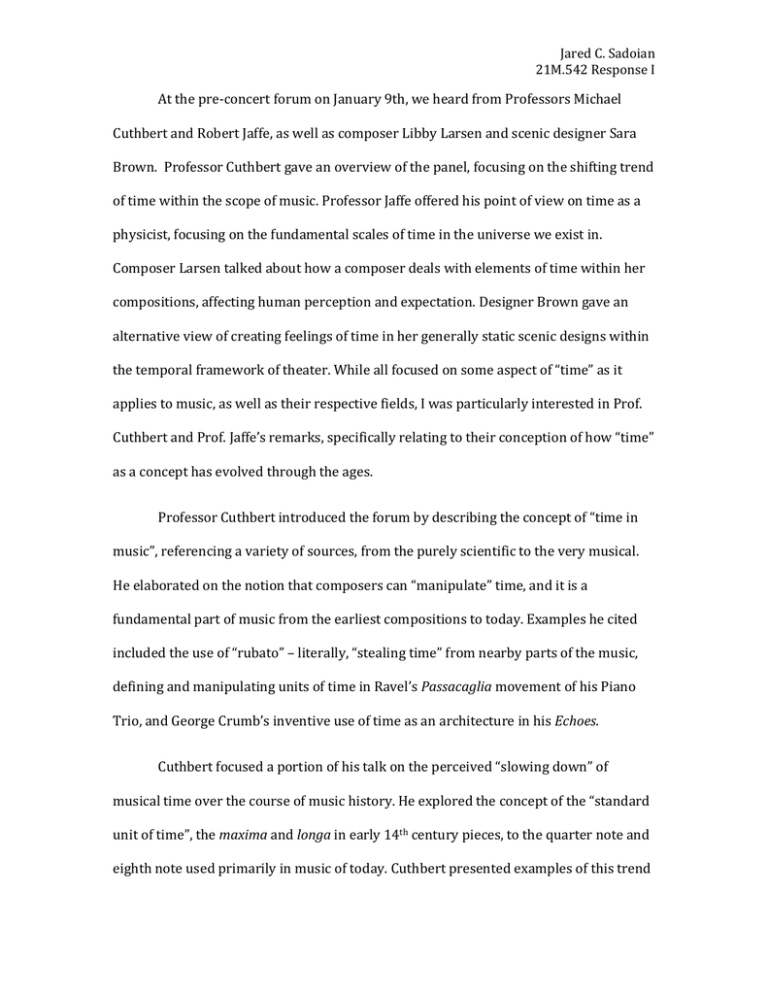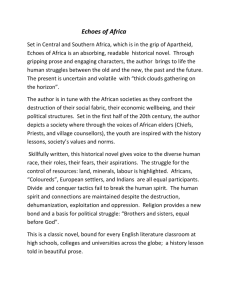At the pre-concert forum on January 9th, we heard from... Cuthbert and Robert Jaffe, as well as composer Libby Larsen...
advertisement

Jared C. Sadoian 21M.542 Response I At the pre-concert forum on January 9th, we heard from Professors Michael Cuthbert and Robert Jaffe, as well as composer Libby Larsen and scenic designer Sara Brown. Professor Cuthbert gave an overview of the panel, focusing on the shifting trend of time within the scope of music. Professor Jaffe offered his point of view on time as a physicist, focusing on the fundamental scales of time in the universe we exist in. Composer Larsen talked about how a composer deals with elements of time within her compositions, affecting human perception and expectation. Designer Brown gave an alternative view of creating feelings of time in her generally static scenic designs within the temporal framework of theater. While all focused on some aspect of “time” as it applies to music, as well as their respective fields, I was particularly interested in Prof. Cuthbert and Prof. Jaffe’s remarks, specifically relating to their conception of how “time” as a concept has evolved through the ages. Professor Cuthbert introduced the forum by describing the concept of “time in music”, referencing a variety of sources, from the purely scientific to the very musical. He elaborated on the notion that composers can “manipulate” time, and it is a fundamental part of music from the earliest compositions to today. Examples he cited included the use of “rubato” – literally, “stealing time” from nearby parts of the music, defining and manipulating units of time in Ravel’s Passacaglia movement of his Piano Trio, and George Crumb’s inventive use of time as an architecture in his Echoes. Cuthbert focused a portion of his talk on the perceived “slowing down” of musical time over the course of music history. He explored the concept of the “standard unit of time”, the maxima and longa in early 14th century pieces, to the quarter note and eighth note used primarily in music of today. Cuthbert presented examples of this trend Sadoian 2 in his talk, and showed in particular the opening of the first echo of Crumb’s work to be performed at the concert, where 16th, 32nd, and 64th notes were employed at what would be perceived by most to be a relatively “slow” tempo. Jaffe, on the other hand, presented a very scientific view of the concept of time, and focused on a theme of “unchangedness”, that time has been moving at the same rate since the formation of the universe. The time scales he spoke of were far outside the time scales synthesized by humans, rather the quantum time scales of the very small, and the cosmological time scales of the extraordinarily large. He stressed that these time scales are very “impersonal”, and for humans to be able to fathom these incredibly large and small values is to distance ourselves from the normally “personal” perception of time. Humans, Jaffe said, must “remove ourselves from human prejudice”, to be able to fully understand it. While both Cuthbert and Jaffe viewed time as a mostly scientifically defined constant. Cuthbert placed greater emphasis on the human element of time, where we create our own scales of time to use in our lives, units like seconds, hours, and years. Although I understand the scientific definition, I feel that we as humans capable of cognition beyond other beings discovered so far, should be able to set these definitions as we see fit, and take time to be something that can be molded, shifted, and changed through various artistic mediums. Even if one is not necessarily educated in music, art, or theater, the experience of such things can still affect our own understanding of how time can be manipulated. The pre-concert forum provided an excellent prelude to the concert of the evening, as it presented a number of complementary and competing views of a subject Sadoian 3 to be explored through the music later in the evening, and gave audience members specific questions and ideas to keep in the mind to better engage them with the music presented. Sadoian 4 The concert featured music exploring aspects of time, Andrew Imbrie’s Serenade Libby Larsen’s Black Birds, Red Hills, George Crumb’s Eleven Echoes of Autumn, and Maurice Ravel’s Piano Trio in A minor. All four works presented different ways of exploring aspects of time, however I found the two most divergent to be Crumb’s Eleven Echoes of Autumn and Larsen’s Black Birds, Red Hills. Crumb’s piece, while extremely stimulating on an imaginative level, was very hard to understand, with many of his echoes seeming fractured and somewhat incoherent. Larsen, on the other hand, wove the idea of “infinity” present in the inspiring works of Georgia O’Keefe into her music, capturing the essence of each of the paintings projected during the concert. Crumb’s Eleven Echoes of Autumn was very well performed, although the music itself was hard to understand. It was very evident during the performance that communication between the players was vital to the success of the piece. Very often, one would see the pianist look over and silently nod to the flautist or clarinetist, signaling the start or end of particular echi. The light show, in particular, was very helpful in communicating to the audience the underlying affect of the piece, and putting into perspective the uniqueness of the sounds emerging from the performers, especially sounds that audiences would not already be familiar with. I did find it difficult to assemble these echoes into a coherent picture in my mind, however. This was due in part to the phenomenon mentioned by some of the panelists, of not being able to “rewind”, or “replay” the music. The performance was the performance, and sometimes I found myself stranded on a particularly difficult passage, attempting to comprehend it while the music played onwards. Sadoian 5 Larsen’s piece, while intensely provocative and imaginative as Crumb’s Echoes was, seemed to me to be much more “digestible”, and showcased her intentions of the music in a very clear manner. Her decidedly slower tempos for the movement for “Red Hills and Sky” in particular helped to instill the feeling of “infinity” that is present in O’Keefe’s painting. I found her style of composition, which utilized short, relatively simple motives in each part that interplayed with other to create a richer sound to be a good basis for promoting O’Keefe’s complex ideas emerging from her simple-looking paintings. I felt that the concert as a whole explored aspects of time as an architecture quite well. The variety of music presented, from the very detached sound of the Crumb to the flowing excitement of the Ravel helped to elucidate the ideas of “time” as presented in the panelists discussion and in the previous seminars during the week. MIT OpenCourseWare http://ocw.mit.edu 21M.542 Interdisciplinary Approaches to Musical Time January IAP 2010 For information about citing these materials or our Terms of Use, visit: http://ocw.mit.edu/terms.


